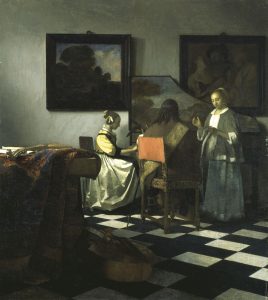TRIP SLAYMAKER ’18
A&E EDITOR
The March, 1990 theft of 13 artworks from the Isabella Stewart Gardner Museum in Boston remains the most valuable single art heist in history. Part of the legend that has built up around the loss and secret movements of the pieces is the result of the strange details of the robbery. Some of the stolen artworks paled in value compared to other works which were left untouched.

That the thieves, who dressed as police officers answering a late-night disturbance call, neglected to recognize one of Titian’s great works, as well as art by Raphael and Botticelli implies that they were amateurs without much knowledge of the paintings. Instead they pried the gilded (but not golden) eagle finial from a Napoleonic flag, taking what they knew were Rembrandts, and the things that appeared outwardly valuable to them. The thieves spent 81 minutes stealing paintings by cutting them out of their frames and attempting to roll them up.
The two men would likely have been surprised to learn later on of the worth of the paintings, which amounted in total to about $500,000,000. Among the losses was Rembrandt’s only known seascape “The Storm on the Sea of Galilee” and the Vermeer masterpiece “the Concert” as well as several other sketches and paintings by the likes of Rembrandt, Degas, and Manet. Recently retired museum director Anne Hawley has called the theft a “crime against civilization.”

Such identifiable and valuable works could not easily have been quickly resold, or for that matter displayed in a private gallery. Representatives at the Gardner Museum expect that the works are kept hidden out of fear of discovery, unable to be sold or seen. In an attempt to raise awareness and increase the likelihood of return, the museum doubled their offered reward for the safe return of all stolen works from 5 million to 10 million in May of 2017. Though the original deadline for the doubled reward was the end of last year, the museum board of trustees determined to lengthen the reward period into 2018.
The Museum has been fastidious about its long search for the stolen artworks, famously retaining the empty frames of each of the stolen paintings in the spots where the masterpieces once hung. Familiarity with the paintings is encouraged, so that in the event that a painting might be spotted, it can be identified.
Several individuals have reported close encounters and even sightings of the stolen works over the years, including a Boston Herald reporter claimed to have been shown one of the lost paintings in person. One of the more promising leads in that 28 year investigation indicated that some of the works had been trafficked into the Hartford area.

The unplanned and spontaneous nature of the 1990 robbery led investigators to the world of the East-coast mafia gang structures. Boston leads pertaining to the unreleased identities of the thieves themselves eventually led investigators to the Hartford branch of La Cosa Nostra. In an interview with the widow of Boston-based bank-robber Robert Guarente, the woman is reported to have detailed an incident where her late husband handed a sheaf of what were purported to be stolen Gardner paintings to Robert Gentile, a low-ranking member of the Mafia who lived in the Hartford area. Investigators were certain enough in this lead to announce publicly that “The FBI believes with a high degree of confidence that in the years after the theft, the art was transported to Connecticut and the Philadelphia region”.

Since that time, FBI attention has returned countless times to the now incarcerated 81-year old. Over many years of interviews with the FBI and the Hartford Courant, Gentile has been fervent in his denial of any connection to the theft. Yet his past interactions with the FBI reveal a failed polygraph and several secretly recorded conversations in which Gentile openly discusses ownership of two of the stolen paintings. Though this evidence suggests Gentile once kept the paintings hidden in Hartford, he has never publicly admitted this. Instead he says that it was only the idea of a “get out of jail free card” that inspired him to lie about his possession of the art. Gentile’s Manchester home has been searched several times for evidence connecting him to the heist, though no sign of the paintings themselves has ever been found. The last search of the premises was in May of 2016, where the FBI were seen to dig up parts of Gentile’s lawn.
Reports of Gentile’s ill health threaten any chance that he will reveal information about the Gardner art. But as a city through which the paintings may have passed, or even stayed in, Hartford is a hot-spot for the Gardner investigation. As long as there are leads of some kind, lovers of art will persist in searching for the missing paintings.



+ There are no comments
Add yours